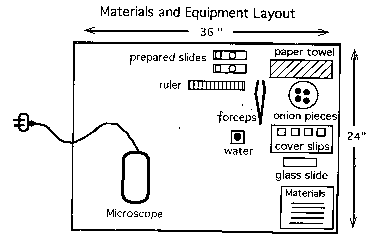 |
 |
|
|
|
|
Grade 9-12 Performance Task Description:In this activity, students will demonstrate their ability to use a compound light microscope through four procedures: preparing a slide, focusing on a slide under the microscope at both low and high power, and measuring the diameter of an onion cell and slide under 100X magnification. This task assesses students' abilities to use scientific equipment appropriately and record accurate measurements. This task is designed to take students approximately 40 minutes to complete. Overall Task Content Area:
Specific Knowledge Areas:
Performance Expectations:
National Science Education Standards:12 A SI 1: Abilities necessary to do scientific
inquiry: Grades 9-12 12 A SI 2: Understandings about scientific
inquiry: Grades 9-12 12 C LS 1: The cell: Grades 9-12 (Use the "hot" link on the PALS home page to check the full text of related National Science Education Standards, if desired.) National Council of Teachers of Mathematics:NO3: Compute fluently and make reasonable
estimates: MEAS2: Apply appropriate techniques, tools,
and formulas to determine measurements: PS2: Solve problems that arise in mathematics
and in other contexts: General Instructions to the Teacher:This task is designed to take approximately 40 minutes to complete. Students will be working individually during this exercise. Students should be ready to work as soon as the period begins. The materials should be set out at each lab station, if possible. A central supply area, if needed, should be easily accessible. All supplies should be clearly labeled. Materials for "Using the Microscope":
Advance Preparation:
Instrument Part and Use Review The following microscope parts and their uses should be reviewed with the students to re-acquaint them with their function.
Focusing Procedure Review The basic technique for focusing a specimen under both low and high power should be briefly reviewed to prevent possible damage to the microscope. Remind students that only the fine adjustment should be used on high power to sharpen the image. Safety:
Extensions/Modifications:None
|

